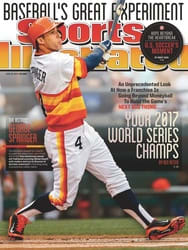
AT THE WORLD CUP
Soccer, everywhere. Soccer in streets choked with traffic, on crowded beaches, in the small villages that dot the muddy shores of the Amazon, outside the mansions and the favelas in Rio de Janeiro and S√£o Paulo. Organized soccer, pickup soccer, even beach volleyball played soccer-style: no hands allowed. The faces of soccer greats painted under highway overpasses, on front porches and outside stadiums, tattooed on arms and legs and backs. Soccer balls on shelves and in backpacks and, one afternoon outside Rio's famous Estàdio do Maracan√£, even one balanced between a forehead and a beer bottle.
The soccer dribble is the heartbeat of Brazil, a country that moves to a distinct rhythm: Life is fluid, loosely coordinated, sometimes chaotic and dysfunctional—but always connected by the ball. Hosting the World Cup only intensifies the country's bond with its national obsession.
For months the tournament portended disaster. There were riots and protests, and the tragic deaths of eight workers in stadium construction accidents. The Brazilian government spent more than $11 billion in the seven years before the World Cup, and little of that money went to the places that most needed it, the hospitals and schools and public transportation systems. Soccer obsession be damned: In a nation where nearly 20% of the population lives in poverty, this felt like an inversion of priorities.
But then the games started, and the furor dimmed, the pendulum swinging back toward what was happening on the field. Brazil opened the World Cup against Croatia at S√£o Paulo's Arena Corinthians on June 12, under a nearly full moon. During the match the city's streets were so empty that they looked abandoned. No one mentioned the protests. No one blasted the politicians.
In a working-class section of Natal, neighbors gathered around a small television perched on top of a storage bin in a road median. The adults drank from bottles of cacha√ßa (sugarcane liquor) in front of a tree spray-painted the colors of the host nation, green and yellow. The nearest house was owned by Geraldo, an older man who wore a Dr. Seuss--style top hat and green plastic sunglasses shaped like intertwined guns. Naturally Geraldo also wore a yellow Brazil jersey, number 10. Everyone in Brazil seems to own one—old, young, rich, poor, pregnant, fat, skinny, short, tall. Businessmen in offices, working girls outside brothels, vendors hawking Brazilian flags down by the beach. Whole families, three generations connected not just by blood but by wardrobe.
The Copa do Mundo unfolded across Brazil in 12 cities, or double the number in play in 1950, the last time the nation hosted. The tournament sprawled from the northwest, where Manaus enticed visitors with piranha fishing in the Solimões and Negro rivers; to the northeast, where a cluster of cities held games near the beach; down the coast, from colonial Salvador to majestic Rio to the concrete maze of industrial São Paulo; down to Porto Alegre and Curitiba, where it was cold.
Everywhere, the thud of soccer balls sounded in the distance. In Brazil soccer is more than the beautiful game—it is the ubiquitous one. Brazilians call the pickup games that break out on any patch of grass or dirt or asphalt where a ball can be kicked pelada. That's also one way to describe a naked woman, which makes sense, because those are perhaps the two things in this world that Brazilian men love most.
The pelada players mimic the pros, or maybe it's the other way around. The pros grew up the same way they did, with games played before school and after school and sometimes during or instead of it. Neymar, who grew up in Mogi das Cruzes, in metropolitan S√£o Paulo, developed that way, as did Fred and Hulk, two more Brazilian stars who require only one name. The same is true of Romàrio, Ronaldo and Rivaldo, who all grew up playing soccer in the street.
As World Cup group play moved through its second week, there were occasional headaches and interruptions. Bus drivers went on strike in Natal, delaying thousands of commuters who stood in long lines near the stadium. Protesters angry about transit fare hikes were met with police tear gas in S√£o Paulo. On June 18 hundreds of ticketless Chilean fans stampeded into Maracan√£ before Chile ended Spain's championship defense with a 2--0 victory. Officials arrested 85 of the intruders after they burst into the media room.
Away from the stadiums, though, the grassroots soccer, the pelada, continued without pause. Students played during the day, restaurant workers at night, businessmen on weekends. They played on beaches packed with surfers, with goals and without, with soccer balls and volleyballs and tennis balls and socks taped into spheres. They played in the middle of roads, dodging traffic. Even Kobe Bryant was filmed getting in on some street footy.
The central question hanging over the World Cup is whether soccer can be transformative, whether the tournament could make Brazil a better country, could have more impact than just a month's worth of tourists and a network of renovated soccer palaces. Of that, the locals remain skeptical. Brazilians are embracing and celebrating the World Cup, though it is with eyes wide-open. They expect little in return. They wanted better schools and better hospitals, more teachers and more doctors and more bus routes and better subway lines. They expect tourists to spend their reals, the local currency, and they expect that when the tournament is over, Brazil will remain the way it was before. They do not anticipate any real change, not as the result of the World Cup.
On the Amazon River, an hour from Manaus, a guide named Orlando spoke of the conflict between what Brazil wants to be and what it is, between what it hopes to accomplish by hosting a World Cup and the next Summer Olympics and what will actually get done. He wore a green World Cup T-shirt and a look of skepticism familiar to his countrymen. "If Brazil succeeds in the World Cup, everything will be O.K.," he said. His definition of success? Improved infrastructure, improved schooling, a narrowing of the gap between rich and poor. "If not," Orlando said, "we will not believe in anything.
"I feel the same way about politics. Too much promise. Too much hope."
Then Orlando grabbed a soccer ball. The boat passed a floating school, a floating hospital, a floating nightclub. Children juggled soccer balls on the riverbanks.
Soccer will continue to define Brazil, to unite a country divided, even if the story of the World Cup and the billions that went into it is that nothing ultimately changes. Maybe that's the legacy. For a month in the summer of 2014, that seems like enough.
PHOTO
PHOTOGRAPH BY SIMON BRUTY/SPORTS ILLUSTRATED
In Brazil any surface can be transformed into a soccer pitch—even this concrete courtyard in a favela in Rio de Janeiro.
FOUR PHOTOS
PHOTOGRAPHS BY SIMON BRUTY/SPORTS ILLUSTRATED
Clockwise from top left: a communal TV in S√£o Paulo; a makeshift field in Rio; beating the drum for soccer in Salvador; soccer solitaire in Salvador.
SEVENTEEN PHOTOS
PHOTOGRAPHS BY SIMON BRUTY/SPORTS ILLUSTRATED
No matter where you go there are reminders of the wunderkind striker Neymar—whether in the form of number 10 jerseys or graffiti images in his honor.
SEVEN PHOTOS
PHOTOGRAPHS BY SIMON BRUTY/SPORTS ILLUSTRATED
An anything-goes vibe reigns on the streets and beaches and in the cafés, but one custom is closely held: A soccer ball and the national colors are never far away.
FOUR ILLUSTRATIONS

